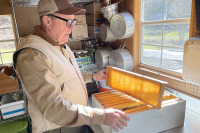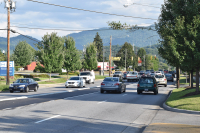Finally, we know just what road we are traveling on
 “She can wiggle her toes.”
“She can wiggle her toes.”
This text message — a simple statement of fact pertaining to my mother — would have seemed absurd just a week ago. It would have meant next to nothing, the punchline to some silly joke maybe.
(“And now, for her next trick ….”)
But today it means everything. It means that a whole multitude of frazzled, sleep-deprived, and borderline desperate people, most of whom are wearing the same clothes they have been wearing for the past four days, most of whom are sleeping two or three or maybe four hours per day, most of whom spend the endless river of hours floating down one of the many tributaries of Wake Forest Baptist Medical Center — to the rest room, to the relaxation lounge, to the vending machines for yet more 65 cent coffee, to the cafeteria, to the elevators, or to the Cardiac Care Unit, Room 20, where my mother, seemingly oblivious to all things, is stretched out on a bed, struggling to breathe, her head thrown back and her mouth wide open, as if she is trying to capture as much oxygen as she can in one enormous gulp, as if all the oxygen in the world is just about to run out entirely.
We take turns going back to see her, two-by-two. We are all secret explorers searching for any trace at all of cognition, there also to project confidence in her recovery even though she has been “asleep” for nearly four full days and cannot be wakened, not by some of the best doctors in the world, not by those who love her and want nothing as much as we want to go back to Sunday, when she was still debating whether to go to church because she was feeling a little ill, maybe, but not ill enough to miss church.
She WAS ill, but did not know how much. How could she? A few hours later she would be vomiting, and then vomiting blood, and then incoherent, then medicated and asleep, and then in an ambulance on her way to Winston-Salem, an hour away. What was happening to her? No one knew.
Related Items
And so for four days, we hold vigil in the waiting room, appropriately named because about the only thing anyone can do in this room is to wait. We wait to see her. Wait to see the doctors. Wait for tiny signs of recovery. Wait for our turn to eat, to sleep — but nobody eats much, and nobody sleeps much. My stepfather eats and sleeps so little — in spite of the insistence of everyone around him that he must take care of himself and keep up his strength — that his own health unravels completely. Now they are both in intensive care, three floors apart, and we go back and forth checking on them, working in teams, to make sure that someone is always there.
In the Cardiac Care waiting room — which is a fairly large room, almost dance hall size — families claim and establish little territories, arranging chairs and tables that insinuate clear, if friendly, boundaries between this family and that one and that one. For the first couple of days, we get used to seeing the same worried faces, the same collective weariness, the same snapping to attention and gathering round when a doctor appears with an update.
On my way back from the cafeteria a little later on, I come upon a woman sobbing into the shoulder of another woman, who has one hand in the crying woman’s hair, another holding her waist, as if they are dancing and not in despair, and I am suddenly seized with the feeling that all of us here are part of the same community, a community formed at the intersection of Heartache and Relief. We have no way of knowing when we come here which road will take us back out, but we will probably wind up on one or the other.
Late on Wednesday night, my brother and I are in my mother’s room again hoping to get one last report before we go to the hotel for whatever sleep we might be able to steal before morning rolls around again. Doctors had hoped that she would show some signs of coming out of her sleep, but she hasn’t. A nurse tells us not to give up, that miracles are possible, that he has personally witnessed miracles. His words are well-intentioned but do not have the desired effect. We leave the hospital thinking that it is time to confront the implacable reality that our mother just is not waking up and may not wake up tomorrow, or the day after that, or any other day.
We get back to the hospital early the next morning for the doctor’s report — no real change — and then report back to the waiting room, where we get a good report from one of the other families on their mother, who is awake and eating food. My first cousin brought over a bushel of baked goodies from Panera Bread, and my little 10-year-old nephew, who has no doubt been pondering why his grandma cannot seem to wake up, asks my sister with complete seriousness, “Have they tried throwing water on her face? I know it sounds mean, but it works.”
We need a good laugh. But in a few hours, we get something we need even worse. For the first time in days, our mother opens her eyes. An hour or two later, she can open them when someone speaks to her, and it is possible to see her eyes focus. And an hour or two after that, she can keep them open and look around.
She is coming back. The coming back turns out to be a very gradual process. She wakes up like a little town wakes up, a few lights here, a few lights there. Her eyes are open, but for a while she cannot move her feet. She cannot squeeze anyone’s hand.
An hour or two later, I am on my way back home, trying to get back in time to see my children, whom I had not seen in three days, when I suddenly got my brother’s text.
“She can wiggle her toes.”
And now I know which road I am on and I just begin singing with the radio, as I often do, and I just take some deep breaths, relishing the air. There is plenty for everybody, after all.
(Chris Cox is a writer and teacher who lives in Haywood County. He can be reached at This email address is being protected from spambots. You need JavaScript enabled to view it..)









